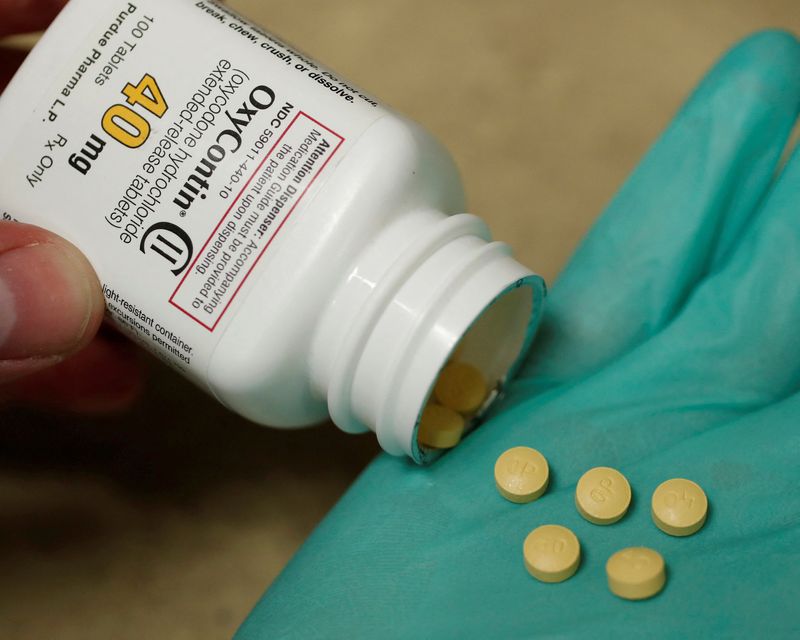By John Kruzel
WASHINGTON (Reuters) - The U.S. Supreme Court is set on Monday to hear arguments over the legality of a roughly $6 billion bankruptcy settlement involving Purdue Pharma, maker of the powerful and highly addictive pain medication OxyContin that played a key role in the country's opioid epidemic.
If the justices allow the deal to proceed, it could lead to billions of dollars being poured into addiction-treatment and other relief efforts. The settlement also would shield the Stamford, Connecticut-based pharmaceutical company's wealthy Sackler family owners from lawsuits brought by opioid victims.
Here is an explanation of the settlement and its consequences.
HOW WOULD THE SETTLEMENT HELP PEOPLE AFFECTED BY OPIOIDS?
An opioid epidemic has caused more than a half million U.S. overdose deaths over a period spanning more than two decades. Purdue introduced OxyContin in 1996, and marketed and promoted it aggressively. OxyContin helped kickstart the epidemic, various plaintiffs have argued in thousands of lawsuits against Purdue. The litigation prompted Purdue in 2019 to file for Chapter 11 bankruptcy to address its debts.
Purdue reached a bankruptcy settlement with creditors, including various state attorneys general, local governments and the U.S. Justice Department's criminal and civil divisions. Under the deal, Purdue would transform into a nonprofit and dedicate its assets to addressing the harms of opioid addiction in the United States.
A U.S. bankruptcy court approved that restructuring plan in 2021. It was revised in 2022 to include more money from the Sacklers after the attorneys general of eight states and the District of Columbia successfully appealed the bankruptcy court approval.
The revised deal is supported by all financial stakeholders in the case, including all state attorneys general, but is opposed by the Justice Department's bankruptcy watchdog and some individual opioid plaintiffs.
Under the deal, the Sacklers would pay up to $6 billion to a trust that would be used to settle claims filed by states, hospitals, people who had become addicted and others who have sued Purdue.
A group comprising more than 60,000 people who have filed personal injury claims stemming from their exposure to Purdue opioid products told the Supreme Court they support the settlement, including legal immunity for members of the Sackler family.
WHAT ROLE DID THE SACKLER FAMILY PLAY IN THE OPIOID CRISIS?
Lawsuits against Purdue and Sackler family members accuse them of fueling the opioid epidemic through deceptive marketing of its pain medication. The company pleaded guilty to misbranding and fraud charges related to its marketing of OxyContin in 2007 and 2020.
The Sacklers' conduct is alleged to have "contributed to the massive overuse of OxyContin and other opioids in this country," according to law professor Joshua Silverstein of the University of Arkansas at Little Rock.
Members of the Sackler family have denied wrongdoing but expressed regret that OxyContin "unexpectedly became part of an opioid crisis." They said in May that the bankruptcy settlement would provide "substantial resources for people and communities in need."
HOW ARE THE SACKLERS TRYING TO USE BANKRUPTCY AS A SHIELD?
Purdue's Sackler family owners under the settlement would receive immunity in exchange for the payment of up to $6 billion to settle thousands of lawsuits, even though they are not bankrupt themselves. They would achieve this through what is called a non-debtor release, also called a third-party release.
"The basic idea is that the Sacklers are providing a great deal of money to Purdue Pharma in exchange for having their own liability for opioid harms extinguished without having to declare bankruptcy," Silverstein said.
Congress initially granted non-debtor releases in the context of asbestos litigation. Their use has been expanded by companies looking to use such releases as a bargaining chip.
President Joe Biden's administration has argued that Purdue's settlement is an abuse of bankruptcy protections meant for debtors in "financial distress," not people like the Sacklers. The administration also has said Sackler family members withdrew $11 billion from Purdue before agreeing to contribute $6 billion to the opioid settlement.
WHY IS THE U.S. TRUSTEE OPPOSING THE BANKRUPTCY SETTLEMENT?
The U.S. Trustee is an office within the Justice Department that carries out an administrative function, performs a watchdog role and in some instances, like in Purdue Pharma's bankruptcy case, takes policy positions.

The watchdog, which is appealing a lower court's ruling approving the settlement, has opposed the use of bankruptcy law to grant sweeping legal protections like those the Sacklers sought. The Trustee told the Supreme Court: "The court of appeals' decision is a roadmap for corporations and wealthy individuals to misuse the bankruptcy system to avoid mass-tort liability."
Purdue has accused the U.S. Trustee of managing to "single-handedly delay billions of dollars in value that should be put to use for victim compensation, opioid crisis abatement for communities across the country and overdose rescue medicines."